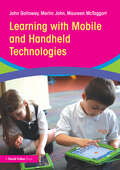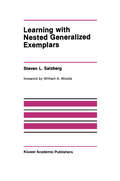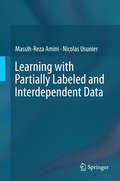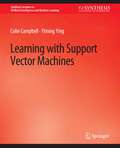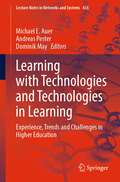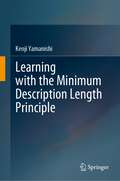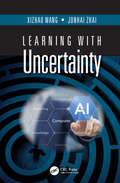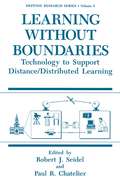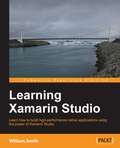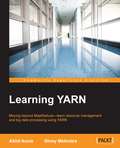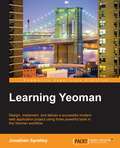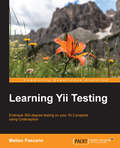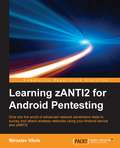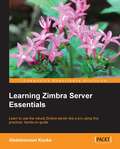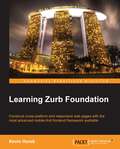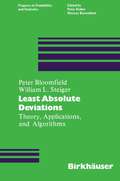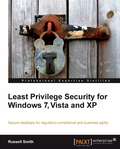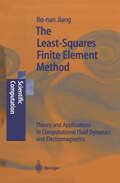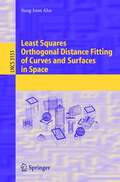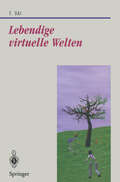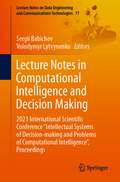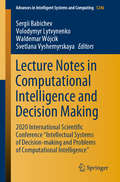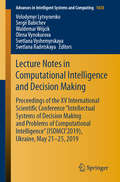- Table View
- List View
Learning with Mobile and Handheld Technologies
by John Galloway Merlin John Maureen McTaggartAs technology evolves we are ever more reliant on the use of handheld and mobile devices, yet what do we know about their impact on learning? While there is a lot of interest in mobile technology, many schools still aren’t sure how to best use it for learning and teaching. Learning with Handhelds and Mobiles explores this landscape and offers examples of how these technologies have been used for learning, how the problems that have arisen are being addressed, and offers ideas for the future. This invaluable book gives a voice to teachers and educators using mobiles and technology-enhanced learning in and out of schools, for regular school work and for innovative projects through exciting partnerships like Apps for Good. Learning with Handhelds and Mobiles shows the changes that are taking place within schools as a direct result of these emerging technologies, and contains case studies with accounts of best practice in a variety of settings including primary, secondary, and special schools, and learning beyond their boundaries. The book also explores themes of pedagogy, communication and affordances, collaborative learning, individual creativity and expression, self-directed and informal learning and outdoor education. The learning potential of handheld and mobile devices has excited teachers and educators, but until now there has been no structured, systematic overview available along with reflections on how this technology is changing educational practice. This book brings these together to provide a clearer picture of what is currently a fragmented area, and offers expert views of how we can understand these, and where it may take us next.
Learning with Nested Generalized Exemplars (The Springer International Series in Engineering and Computer Science #100)
by Steven L. SalzbergMachine Learning is one of the oldest and most intriguing areas of Ar tificial Intelligence. From the moment that computer visionaries first began to conceive the potential for general-purpose symbolic computa tion, the concept of a machine that could learn by itself has been an ever present goal. Today, although there have been many implemented com puter programs that can be said to learn, we are still far from achieving the lofty visions of self-organizing automata that spring to mind when we think of machine learning. We have established some base camps and scaled some of the foothills of this epic intellectual adventure, but we are still far from the lofty peaks that the imagination conjures up. Nevertheless, a solid foundation of theory and technique has begun to develop around a variety of specialized learning tasks. Such tasks in clude discovery of optimal or effective parameter settings for controlling processes, automatic acquisition or refinement of rules for controlling behavior in rule-driven systems, and automatic classification and di agnosis of items on the basis of their features. Contributions include algorithms for optimal parameter estimation, feedback and adaptation algorithms, strategies for credit/blame assignment, techniques for rule and category acquisition, theoretical results dealing with learnability of various classes by formal automata, and empirical investigations of the abilities of many different learning algorithms in a diversity of applica tion areas.
Learning with Partially Labeled and Interdependent Data
by Massih-Reza Amini Nicolas UsunierThis book develops two key machine learning principles: the semi-supervised paradigm and learning with interdependent data. It reveals new applications, primarily web related, that transgress the classical machine learning framework through learning with interdependent data. The book traces how the semi-supervised paradigm and the learning to rank paradigm emerged from new web applications, leading to a massive production of heterogeneous textual data. It explains how semi-supervised learning techniques are widely used, but only allow a limited analysis of the information content and thus do not meet the demands of many web-related tasks.Later chapters deal with the development of learning methods for ranking entities in a large collection with respect to precise information needed. In some cases, learning a ranking function can be reduced to learning a classification function over the pairs of examples. The book proves that this task can be efficiently tackled in a new framework: learning with interdependent data.Researchers and professionals in machine learning will find these new perspectives and solutions valuable. Learning with Partially Labeled and Interdependent Data is also useful for advanced-level students of computer science, particularly those focused on statistics and learning.
Learning with Support Vector Machines (Synthesis Lectures on Artificial Intelligence and Machine Learning)
by Colin Pigozzi Yiming GeneserethSupport Vectors Machines have become a well established tool within machine learning. They work well in practice and have now been used across a wide range of applications from recognizing hand-written digits, to face identification, text categorisation, bioinformatics, and database marketing. In this book we give an introductory overview of this subject. We start with a simple Support Vector Machine for performing binary classification before considering multi-class classification and learning in the presence of noise. We show that this framework can be extended to many other scenarios such as prediction with real-valued outputs, novelty detection and the handling of complex output structures such as parse trees. Finally, we give an overview of the main types of kernels which are used in practice and how to learn and make predictions from multiple types of input data. Table of Contents: Support Vector Machines for Classification / Kernel-based Models / Learning with Kernels
Learning with Technologies and Technologies in Learning: Experience, Trends and Challenges in Higher Education (Lecture Notes in Networks and Systems #456)
by Michael E. Auer Andreas Pester Dominik MayEducation has always been one of the cornerstones for societal evolution and economic growth. We are currently witnessing a significant transformation in the development of education and especially post-secondary education.The use of technology impacts the way educational content is presented and acquired in many areas. The designs of immersive educational worlds and the combination of rational and emotional educational experiences that cannot be designed in the same way in the traditional classroom will come increasingly into focus.Seen in this way the book also contributes to generalize the experience of the COVID-19 crisis and its impact to quality of learning and education.Scientifically based statements as well as excellent experiences (best practice) are necessary. This book contains scientific papers in the fields of: The future of learning Eruptive technologies in learningPedagogy of online learning Deep learning vs machine learning: opportunities and challengesReimagining and rapid transition of learningInterested readership includes policymakers, academics, educators, researchers in pedagogy and learning theory, schoolteachers, learning industry, further and continuing education lecturers, etc.
Learning with the Minimum Description Length Principle
by Kenji YamanishiThis book introduces readers to the minimum description length (MDL) principle and its applications in learning. The MDL is a fundamental principle for inductive inference, which is used in many applications including statistical modeling, pattern recognition and machine learning. At its core, the MDL is based on the premise that “the shortest code length leads to the best strategy for learning anything from data.” The MDL provides a broad and unifying view of statistical inferences such as estimation, prediction and testing and, of course, machine learning.The content covers the theoretical foundations of the MDL and broad practical areas such as detecting changes and anomalies, problems involving latent variable models, and high dimensional statistical inference, among others. The book offers an easy-to-follow guide to the MDL principle, together with other information criteria, explaining the differences between their standpoints. Written in a systematic, concise and comprehensive style, this book is suitable for researchers and graduate students of machine learning, statistics, information theory and computer science.
Learning with Uncertainty
by Xizhao Wang Junhai ZhaiLearning with uncertainty covers a broad range of scenarios in machine learning, this book mainly focuses on: (1) Decision tree learning with uncertainty, (2) Clustering under uncertainty environment, (3) Active learning based on uncertainty criterion, and (4) Ensemble learning in a framework of uncertainty. The book starts with the introduction to uncertainty including randomness, roughness, fuzziness and non-specificity and then comprehensively discusses a number of key issues in learning with uncertainty, such as uncertainty representation in learning, the influence of uncertainty on the performance of learning system, the heuristic design with uncertainty, etc. Most contents of the book are our research results in recent decades. The purpose of this book is to help the readers to understand the impact of uncertainty on learning processes. It comes with many examples to facilitate understanding. The book can be used as reference book or textbook for researcher fellows, senior undergraduates and postgraduates majored in computer science and technology, applied mathematics, automation, electrical engineering, etc.
Learning with Uncertainty
by Xizhao Wang Junhai ZhaiLearning with uncertainty covers a broad range of scenarios in machine learning, this book mainly focuses on: (1) Decision tree learning with uncertainty, (2) Clustering under uncertainty environment, (3) Active learning based on uncertainty criterion, and (4) Ensemble learning in a framework of uncertainty. The book starts with the introduction to uncertainty including randomness, roughness, fuzziness and non-specificity and then comprehensively discusses a number of key issues in learning with uncertainty, such as uncertainty representation in learning, the influence of uncertainty on the performance of learning system, the heuristic design with uncertainty, etc. Most contents of the book are our research results in recent decades. The purpose of this book is to help the readers to understand the impact of uncertainty on learning processes. It comes with many examples to facilitate understanding. The book can be used as reference book or textbook for researcher fellows, senior undergraduates and postgraduates majored in computer science and technology, applied mathematics, automation, electrical engineering, etc.
Learning without Boundaries: Technology to Support Distance/Distributed Learning (Defense Research Series #5)
by Robert J. Seidel Paul R. ChatelierThis collection of papers is the result of a workshop sponsored by NATO's Defense Research Group Panel 8 during the Fall of 1993. The workshop was held at the University of German Armed Forces at Neubiberg (Munich) Germany 29 September-l October, 1993. Robert J. Seidel Paul R. Chatelier U.S. Army Research Institute for the Executive Office of the President Behavioral and Social Sciences Office of Science and Technology Policy Washington, D.C. Washington, D.C. v PREFACE We would like to thank the authors of the papers for providing an excellent coverage of this rapidly developing technology, the session chairpersons for providing excellent structure and management for each group of papers, and each session's discussant's for their summary and personal views of their sessions papers. Our special thanks go to Dr. Rolfe Otte, the German ministry of Defense's research study group member and the person responsible for our being able to have this workshop in Munich. We are also grateful to Dr. H. Closhen of the IABG for technical and administrative assistance throughout the planning and conduct of the workshop.
Learning Xamarin Studio
by William SmithThis book is intended for .NET developers with any level of experience and who are interested in building native applications without the hassle of becoming Objective-C or Java experts. Although it will be beneficial to have some development experience, particularly in .NET, Learning Xamarin help even a novice developer get past the headaches of setting up and customizing their new development environment so they can move on to producing high-quality native applications quickly.
Learning YARN
by Akhil Arora Shrey MehrotraMoving beyond MapReduce - learn resource management and big data processing using YARN About This Book • Deep dive into YARN components, schedulers, life cycle management and security architecture • Create your own Hadoop-YARN applications and integrate big data technologies with YARN • Step-by-step guide to provision, manage, and monitor Hadoop-YARN clusters with ease Who This Book Is For This book is intended for those who want to understand what YARN is and how to efficiently use it for the resource management of large clusters. For cluster administrators, this book gives a detailed explanation of provisioning and managing YARN clusters. If you are a Java developer or an open source contributor, this book will help you to drill down the YARN architecture, write your own YARN applications and understand the application execution phases. This book will also help big data engineers explore YARN integration with real-time analytics technologies such as Spark and Storm. What You Will Learn • Explore YARN features and offerings • Manage big data clusters efficiently using the YARN framework • Create single as well as multi-node Hadoop-YARN clusters on Linux machines • Understand YARN components and their administration • Gain insights into application execution flow over a YARN cluster • Write your own distributed application and execute it over YARN cluster • Work with schedulers and queues for efficient scheduling of applications • Integrate big data projects like Spark and Storm with YARN In Detail Today enterprises generate huge volumes of data. In order to provide effective services and to make smarter and more intelligent decisions from these huge volumes of data, enterprises use big-data analytics. In recent years, Hadoop has been used for massive data storage and efficient distributed processing of data. The Yet Another Resource Negotiator (YARN) framework solves the design problems related to resource management faced by the Hadoop 1.x framework by providing a more scalable, efficient, flexible, and highly available resource management framework for distributed data processing. This book starts with an overview of the YARN features and explains how YARN provides a business solution for growing big data needs. You will learn to provision and manage single, as well as multi-node, Hadoop-YARN clusters in the easiest way. You will walk through the YARN administration, life cycle management, application execution, REST APIs, schedulers, security framework and so on. You will gain insights about the YARN components and features such as ResourceManager, NodeManager, ApplicationMaster, Container, Timeline Server, High Availability, Resource Localisation and so on. The book explains Hadoop-YARN commands and the configurations of components and explores topics such as High Availability, Resource Localization and Log aggregation. You will then be ready to develop your own ApplicationMaster and execute it over a Hadoop-YARN cluster. Towards the end of the book, you will learn about the security architecture and integration of YARN with big data technologies like Spark and Storm. This book promises conceptual as well as practical knowledge of resource management using YARN. Style and approach Starting with the basics and covering the core concepts with the practical usage, this tutorial is a complete guide to learn and explore YARN offerings.
Learning Yeoman
by Jonathan SpratleyIf you are a web developer with some experience in JavaScript and want to enter the world of modern web applications, then this book is ideal for you. Learning how to leverage the three tools (Yo, Bower, and Grunt) in the Yeoman workflow will be perfect as your next step towards building scalable, dynamic, and modern web applications for just about any platform.
Learning Yii Testing
by Matteo PescarinDevelopers who have a solid pre-existing knowledge of Yii's core concepts will find this book an ideal introduction to learning to write tests using Yii 2's tools. You'll learn to create faster and more reliable applications with less time and effort.
Learning zANTI2 for Android Pentesting
by Miroslav VitulaDive into the world of advanced network penetration tests to survey and attack wireless networks using your Android device and zANTI2 About This Book • Understand the basics of wireless penetration testing and its importance • Learn the techniques to perform penetration testing on your wireless networks, such as scanning, detecting vulnerabilities in your victim, and then attacking • This simple and intriguing guide takes a step-by-step approach that will help you get to grips with network pentesting using just your Android device and zANTI2 Who This Book Is For The book is intended for those who want to know more about network penetration tests and have no prior experience, as well as for those who are experienced in network systems and are curious to discover more about this topic. Since zANTI2 features an extremely intuitive and easy to control interface, it doesn't require any special skills. What You Will Learn • Understand the importance of penetration testing throughout systems • Take a run through zANTI2's interface and understand the requirements to the app • Perform advanced scanning/network mapping and discover the various types of scans used on a target • Discover and remotely connect to open ports on a target, thereby accessing a target's files and folders remotely • Detect vulnerabilities on a target, learn how to remotely exploit them, and discover ways to protect your self from these exploits • Understand what an MITM attack is and how it works, and apply this knowledge to perform attacks on network targets • Learn to hijack sessions, identify victim's passwords, replace images on websites, inject scripts, and more • Use this knowledge to protect yourself from all of the attacks you will study In Detail A penetration test is one of the most important methods to secure a network or any individual machine. Having knowledge of these methods can enable a user to protect himself/herself from any kinds of attacks. Penetration tests can also be used to discover flaws or loop holes in one's security system, which if not fixed, can be exploited by an unwanted entity. This book starts off with an introduction to what penetration testing is, and how it can be performed on Android using zANTI2. Once you are aware of the basics, we move on to teach you the different types of scans that can be performed to search for targets. You will then learn how to connect to open ports and intrude into an unsecured computer. From here you will explore vulnerabilities and their usage, including ShellShock and SSL Poodle vulnerability. When connected to an open network, a user is susceptible to password and session hijacking, and a number of other cyber attacks. The book therefore ends with one of the main aspects of cyber security: the Man in the Middle attack. You will get to know everything about the MITM attack, how it works, and how one can be protected against it. Style and approach The book follows a step-by-step approach with each of the parts explained in an easy-to-follow style. Most of the methods showcased can be tried out immediately on almost any network.
Learning Zimbra Server Essentials
by Abdelmonam KoukaA standard tutorial approach which will guide the readers on all of the intricacies of the Zimbra Server.If you are any kind of Zimbra user, this book will be useful for you, from newbies to experts who would like to learn how to setup a Zimbra server. If you are an IT administrator or consultant who is exploring the idea of adopting, or have already adopted Zimbra as your mail server, then this book is for you. No prior knowledge of Zimbra is required.
Learning Zurb Foundation
by Kevin HorekIf you are a web designer, developer, or anyone who is interested in building responsive websites, then this book is a must-have. Basic knowledge of CSS, HTML, and JavaScript is required.
Least Absolute Deviations: Theory, Applications and Algorithms (Progress in Probability #6)
by P- Bloomfield SteigerLeast squares is probably the best known method for fitting linear models and by far the most widely used. Surprisingly, the discrete L 1 analogue, least absolute deviations (LAD) seems to have been considered first. Possibly the LAD criterion was forced into the background because of the com putational difficulties associated with it. Recently there has been a resurgence of interest in LAD. It was spurred on by work that has resulted in efficient al gorithms for obtaining LAD fits. Another stimulus came from robust statistics. LAD estimates resist undue effects from a feyv, large errors. Therefore. in addition to being robust, they also make good starting points for other iterative, robust procedures. The LAD criterion has great utility. LAD fits are optimal for linear regressions where the errors are double exponential. However they also have excellent properties well outside this narrow context. In addition they are useful in other linear situations such as time series and multivariate data analysis. Finally, LAD fitting embodies a set of ideas that is important in linear optimization theory and numerical analysis. viii PREFACE In this monograph we will present a unified treatment of the role of LAD techniques in several domains. Some of the material has appeared in recent journal papers and some of it is new. This presentation is organized in the following way. There are three parts, one for Theory, one for Applicatior.s and one for Algorithms.
Least Privilege Security for Windows 7, Vista and XP: Implement Efficient System Security By Assigning Permissions Effectively
by Russell SmithThis practical handbook has detailed step-by-step instructions for implementing Least Privilege Security and related management technologies. It has solutions to the most common technical challenges and Microsoft best practice advice. It also covers techniques for managing Least Privilege on the desktop. This book is for System Administrators or desktop support staff who want to implement Least Privilege Security on Windows systems.
The Least-Squares Finite Element Method: Theory and Applications in Computational Fluid Dynamics and Electromagnetics (Scientific Computation)
by Bo-nan JiangThis is the first monograph on the subject, providing a comprehensive introduction to the LSFEM method for numerical solution of PDEs. LSFEM is simple, efficient and robust, and can solve a wide range of problems in fluid dynamics and electromagnetics.
Least Squares Orthogonal Distance Fitting of Curves and Surfaces in Space (Lecture Notes in Computer Science #3151)
by Sung Joon AhnDue to the continuing progress of sensor technology, the availability of 3-D cameras is already foreseeable. These cameras are capable of generating a large set of measurement points within a very short time. There are a variety of 3-D camera applications in the fields of robotics, rapid product development and digital factories. In order to not only visualize the point cloud but also to recognize 3-D object models from the point cloud and then further process them in CAD systems, efficient and stable algorithms for 3-D information processing are required. For the automatic segmentation and recognition of such geometric primitives as plane, sphere, cylinder, cone and torus in a 3-D point cloud, efficient software has recently been developed at the Fraunhofer IPA by Sung Joon Ahn. This book describes in detail the complete set of ‘best-fit’ algorithms for general curves and surfaces in space which are employed in the Fraunhofer software.
Lebendige virtuelle Welten: Physikalisch-basierte Modelle in Computeranimation und virtueller Realität (Beiträge zur Graphischen Datenverarbeitung)
by Fan DaiIn Computeranimation und virtueller Realität geht es neben optischer Darstellungsqualität auch darum, dynamische Änderungen (Bewegung, Verformung, etc.) realistisch wiederzugeben. Das Buch liefert einen Überblick über die Methoden von Modellierung und Simulation dynamischer Prozesse in virtuellen, computergenerierten Welten. Das umfaßt die Dynamik von Mehrkörpersystemen, kinematischen Strukturen und verformbaren Objekten bis hin zu virtuellen "Lebewesen". Dabei werden neben den technischen Grundkonzepten aktuelle Ansätze aus der Forschung dargestellt.
Lecture Notes in Computational Intelligence and Decision Making: 2021 International Scientific Conference "Intellectual Systems of Decision-making and Problems of Computational Intelligence”, Proceedings (Lecture Notes on Data Engineering and Communications Technologies #77)
by Sergii Babichev Volodymyr LytvynenkoThis book is devoted to current problems of artificial and computational intelligence including decision-making systems. Collecting, analysis, and processing information are the current directions of modern computer science. Development of new modern information and computer technologies for data analysis and processing in various fields of data mining and machine learning creates the conditions for increasing effectiveness of the information processing by both the decrease of time and the increase of accuracy of the data processing. The book contains of 54 science papers which include the results of research concerning the current directions in the fields of data mining, machine learning, and decision making. The papers are divided in terms of their topic into three sections. The first section "Analysis and Modeling of Complex Systems and Processes" contains of 26 papers, and the second section "Theoretical and Applied Aspects of Decision-Making Systems" contains of 13 papers. There are 15 papers in the third section "Computational Intelligence and Inductive Modeling". The book is focused to scientists and developers in the fields of data mining, machine learning and decision-making systems.
Lecture Notes in Computational Intelligence and Decision Making: 2020 International Scientific Conference "Intellectual Systems of Decision-making and Problems of Computational Intelligence” (Advances in Intelligent Systems and Computing #1246)
by Sergii Babichev Volodymyr Lytvynenko Waldemar Wójcik Svetlana VyshemyrskayaThis book includes 46 scientific papers presented at the conference and reflecting the latest research in the fields of data mining, machine learning and decision-making. The international scientific conference “Intellectual Systems of Decision-Making and Problems of Computational Intelligence” was held in the Kherson region, Ukraine, from May 25 to 29, 2020. The papers are divided into three sections: “Analysis and Modeling of Complex Systems and Processes,” “Theoretical and Applied Aspects of Decision-Making Systems” and “Computational Intelligence and Inductive Modeling.” The book will be of interest to scientists and developers specialized in the fields of data mining, machine learning and decision-making systems.
Lecture Notes in Computational Intelligence and Decision Making: Proceedings of the XV International Scientific Conference “Intellectual Systems of Decision Making and Problems of Computational Intelligence” (ISDMCI'2019), Ukraine, May 21–25, 2019 (Advances in Intelligent Systems and Computing #1020)
by Volodymyr Lytvynenko Sergii Babichev Waldemar Wójcik Olena Vynokurova Svetlana Vyshemyrskaya Svetlana RadetskayaInformation and computer technologies for data analysis and processing in various fields of data mining and machine learning generates the conditions for increasing the effectiveness of information processing by making it faster and more accurate. The book includes 49 scientific papers presenting the latest research in the fields of data mining, machine learning and decision-making. Divided into three sections: “Analysis and Modeling of Complex Systems and Processes”; “Theoretical and Applied Aspects of Decision-Making Systems”; and “Computational Intelligence and Inductive Modeling”, the book is of interest to scientists and developers in the field.
